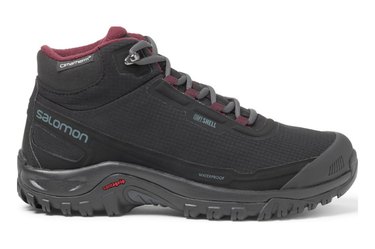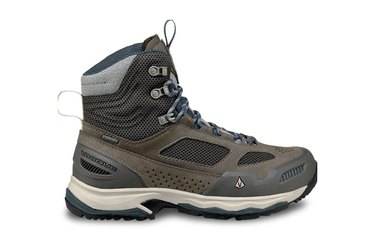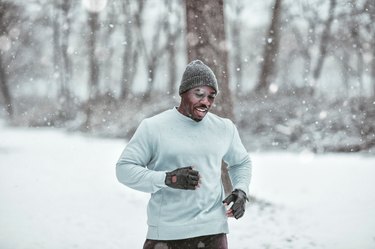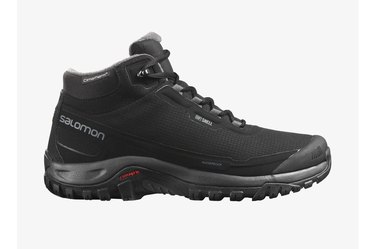
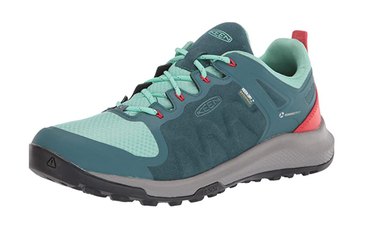
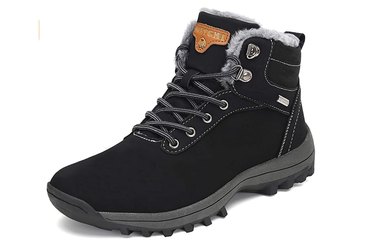
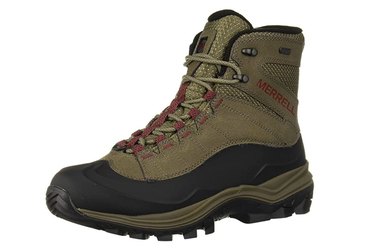

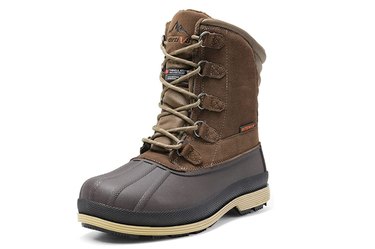
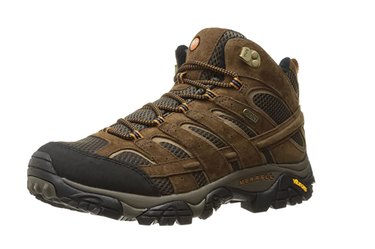
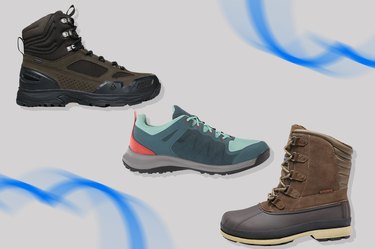

During winter walks, the last thing you want is wet socks and cold feet. Enter, cold-weather walking shoes. Designed with thick rubber soles, thick waterproof uppers and grippy soles, they not only keep your feet warm — they keep you stable on uneven snowy and icy surfaces.
That translates to more comfortable, safer walks as well as better walking and hiking workouts, says Melissa Garcia, DPT, CSCS, a Washington-based physical therapist who's no stranger to cold-weather walks.
Video of the Day
Video of the Day
Here are the absolute best winter walking shoes on the market, and what you should look for before investing in your own pair.
How We Chose
We chatted with Garcia to learn what makes the safest, most comfortable walking shoe for winter. You may notice most of these actually look like a hiking boot, rather than a shoe — that's because ankle protection and stability are a must when walking on snowy, slippery surfaces.
After some research, we narrowed down our top picks based on the following criteria:
- Upper material
- Height
- Traction
- Ankle Protection
A Quick Language Note
We make deliberate choices about the language we use, but most manufacturers typically market shoes according to gender, so we've listed both women's and men's picks below.
However, the main difference between most men's and women's shoes is shoe width and size. In some cases, men's shoes are built to support greater weights. So people with bigger bodies may opt for men's versions, whereas people with smaller bodies may prefer women's versions. Choose whichever option feels best for you!
1. Best Overall: Salomon Shelter ClimaSalomon Waterproof
- Upper Material: rubber
- Terrain: sidewalks with shallow snow or ice
- Feature: comfortable weatherproof upper
These cold-weather walking shoes are a favorite of Garcia, thanks to their fully waterproof and insulated uppers. The rubber outsole helps prevent slips and falls, and has a good level of traction.
While they work for a variety of winter activities, they're better for snowy sidewalks than they are wilderness hikes.
Buy it: REI.com (women's); Deporvillage.net (men's) Price: $139.95 (women's); $130.52 (men's)
2. Best for Low Snow: KEEN Explore Waterproof Hiking Shoe
- Upper Material: double layer mesh
- Terrain: sidewalks with shallow snow
- Feature: high heel fabric for extra stability
These low-snow walking shoes are waterproof, high-traction and have a low ankle cut, Garcia says. The upper is made of a flexible performance mesh that has double layers for warmth and durability.
Plus, the heel fabric comes up pretty high, so you don't have to worry about your foot moving or popping out of the shoe if the ground gets extra slushy. Keen's women's winter walking shoe version is a little pricier than the men's, so if your size allows, you can opt for the men's version to save some money.
Buy it: Amazon.com (men's); Amazon.com (women's); Price: $90.33 (men's); $68.98 (women's)
3. Best for Deep Snow: Mishansha Winter Ankle Snow Hiking Boots
- Upper Material: artificial leather
- Terrain: any snowy or icy terrain
- Feature: slip-preventing, protective rubber toe cap
When it comes to walking through deep snow, these high-reaching hiking boots provide everything you need, according to Garcia. They're insulated with a thick faux-fur lining and sole for a comfortable, toasty feel.
The outsole is made of a flexible, non-skid rubber, while the toecap provides some extra resistance against slips and falls. It also helps guard your toes from injury.
Buy it: Amazon.com; Price: $35.99
4. Best for Water Protection: Merrell Thermo Chill 6" Shell Waterproof Sneaker
- Upper Material: waterproof leather and mesh
- Terrain: any snowy or icy terrain
- Feature: flexible sole
Merrell's boot-inspired sneaker is one of the best shoes for walking on snow and ice. The upper is totally waterproof and insulated, perfect for a chilly walk to the store or a frigid hike. Garcia is also a fan of the higher ankle, which helps improve your stability on unstable ground (like black ice).
Another bonus? Unlike most winter hiking shoes, the soles of these boots are actually pretty flexible, allowing you to tread with more agility and comfort.
Buy it: Amazon.com (men's); Amazon.com (women's); Price: $78.27
5. Best for Hikes: Vasque Breeze AT Mid GTX
- Upper Material: waterproof GORE-TEX mesh
- Terrain: any snowy or icy terrain
- Feature: secure lace closure
Vasque makes some of the best hiking shoes around, according to Garcia. And if you're a fan of snowy hikes, its Breeze is the one to add to your cart.
Extra supportive with a wind- and waterproof upper, it can withstand all kinds of winter weather. And the high-traction sole is excellent for walking on icy paths.
6. Best for Cold Temperatures: NORTIV 8 Insulated Waterproof Work Winter Snow Boots
- Upper Material: leather
- Terrain: any snowy or icy terrain
- Feature: protection from extremely low temperatures
People who live in or are traveling to especially cold climates will appreciate NORTIV 8's insulated winter boots, Garcia says. With their leather, weather-proof upper, they're rated to stay warm in temperatures as low as -25F. And the water-resistant fabric seals out any moisture.
Bonus: The company offers a warranty in case you buy the wrong size or have any issues with your shoes.
Buy it: Amazon.com (men's); Amazon.com (women's); Price: $52.99 - $75.99 (men's); $29.99 - $39.99 (women's)
7. Best for Uneven Ground: Merrell Moab 2 Mid Waterproof Hiking Boot
- Upper Material: leather and mesh
- Terrain: any snowy or icy terrain
- Feature: protection from extremely low temperatures
Merrell is known for making solid walking and hiking shoes, and the Moab hiking boots are no exception. They're totally waterproof and built for stability on uneven or slippery terrain, thanks to the durable, slip-proof ridges on the sole, according to Garcia.
These also have a wide, water-repelling tongue that helps keep debris, snow or water off your socks when the weather gets brutal.
Buy it: Amazon.com (men's); Amazon.com (women's); Price: $86.99
4 Factors to Look for in a Pair of Winter Walking Shoes
1. Weather Protection
Walking in the winter is a great way to get in a workout and warm up at the same time. In the winter, though, you need to think about protection from the elements, according to Garcia.
The best shoes for walking in snow or on ice have completely waterproof soles to keep your feet safe from cold air, snow and slush. Inside the shoe, look for good insulation: The best shoes for walking on ice will have linings made with water-resistant insulation to keep warmth locked in. If the shoes you select aren't waterproof, seal them with water sealer before heading out on your winter walks.
Thermal fabrics, leather, suede and rubber are all good weather-proof materials to prioritize. Before you buy a pair, read the product description to make sure the shoes you're buying meet this criteria.
That said, don't buy a shoe or boot that provides too much warmth. You don't want your feet to get sweaty, which can in turn make them even colder. It's generally better to get a moderate to light boot with a good sole and wear wool or polar fleece socks under them than to get too heavy of boot and have to wear thin socks.
2. Height
Warm walking shoes and boots come in all different heights, from ankle to mid-calf. Look for lightweight hiker-style boots with a high ankle or mid-calf height that are waterproof or at least water-resistant, so that when you encounter slushy puddles, you don't end up with a shoe full of slush.
The best shoe height for you depends on the conditions and location of your winter walks, Garcia says. People who live in urban settings without too much deep snow can likely get away with a shorter cut because the snow usually isn't too deep.
Those who like to take their walks in more rural, snowy areas may want to consider higher boots for some extra warmth and protection.
Taller pairs also make great shoes for walking on ice because they offer more ankle protection in case of slips and falls. So, if you tend to cross patches of ice pretty frequently, you may want to consider above-the-ankle shoes.
3. Traction
The best winter walking shoes are high on traction. When you walk up or down hills on snow- or ice-covered ground, you need as much stability as possible.
The best shoes for walking on snow and ice have a rubber outsole and deep rubber ridges on the bottom. Also known as lugs, these help minimize your risk of slipping as you cross or climb up and down unstable ground or ice.
Be sure to check the bottom of your shoes periodically for signs of wear. Once the tread has started to wear down and the soles are more smooth, it's likely time for a new pair.
Warning
The Canada Safety Council notes that you can also attach ice grippers to your shoes to help you walk on ice. Be sure to remove them before walking on a smooth surface like stone, ceramic or tile, however, as they may cause you to slip and fall once you leave the ice.
4. Comfort
The best shoes for snow and ice are ones that feel comfortable on your feet, Garcia says. Always check the sizing chart and reviews before you buy a pair because some companies may size differently and some shoes may run a little big or small.
Also, consider going half a size up considering you're probably going to wear thicker socks in colder temperatures. Pro tip: Double check company return policies in case you order a pair that ends up being a little too tight or roomy. Most outdoor shoe manufacturers have pretty lenient rules but it's always nice to have some extra security.
Although materials and construction play the biggest role in creating the best shoes for walking on ice, shoppers commonly overlook other important factors. Make sure your shoe fits snugly; if it doesn't, no amount of technology will keep you from slipping on ice.
A Note on Sizing Winter Walking Shoes
Don't forget to bring socks of the same thickness and style that you'll wear during the winter with you when you try on different shoes. If you think you'll wear two pairs of socks sometimes, then bring them both.
It's an awful feeling to put on your new shoes only to find that they're impossible to lace properly because you have too many layers underneath.
5. Your Budget
Normal walking shoes tend to cost well under $100, but the best shoes for walking in snow or on ice will probably be a little pricer because they use weather-friendly materials and involve more complex engineering. Generally, you can expect to spend somewhere around $100 to $150.
While this may seem steep, the best shoes for walking on ice will keep you from slipping and falling, so they're definitely worth the price tag. But for those on a lower budget, you can definitely find some lower-priced options online.
